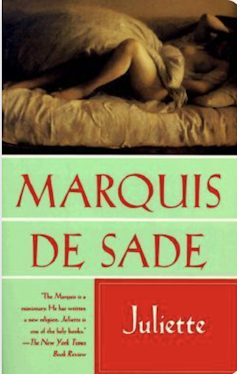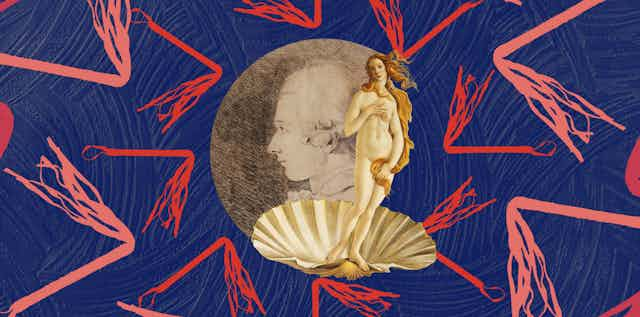In our feminist classics series, we look at influential books.
Social constructs and questions of control are preoccupations the late British writer Angela Carter returns to time and time again. This is especially true of the inflammatory piece of feminist non-fiction Carter published in 1979: The Sadeian Woman: And the Ideology of Pornography.
Carter, who died from cancer in 1992, was a true creative trailblazer. A novelist, fabulist, journalist and editor, deeply influenced by the women’s movement of the 1960s, she played with genres from fairy-tales and science fiction to magic realism and radio drama. She is known for works such as The Bloody Chamber (1979) and Wise Children (1991).

Her work is eerily prescient and continues to resonate. The Passion of New Eve (1977), for instance, is a transgressive feminist novel set in a post-apocalyptic United States. Tellingly, Carter described this novel as an “anti-mythic” work about “the social creation of femininity”.
Two years later, she published her take on the French writer the Marquis de Sade (1740-1814). Commissioned by the feminist publishing house, Virago, The Sadeian Woman attempts the near impossible, claiming Sade as a proto-feminist author.
Read more: What are the four waves of feminism? And what comes next?
Fact from fiction
Novelist Francine du Plessix Gray has described Sade (whose real name was Donatien Alphonse François) as “one of the few men in history whose names have spawned adjectives” and “the only writer who will never lose his capacity to shock us.”
But who was he? Carter’s introductory note to The Sadeian Woman is useful:
Sade was born in 1740, a great nobleman; and died in 1814, in a lunatic asylum, a poor man. His life spans the entire period of the French Revolution and he died in the same year that Napoleon abdicated and the monarchy was restored to France. He stands on the threshold of the modern period, looking both backward and forwards, at a time when the nature of human nature and of social institutions was debated as freely as it is in our own.
Yet Carter neglects to mention Sade is one of the most notorious writers in recorded history.
Insane pornographer. Sexual pervert. Woman beater. Child rapist. Murderer. As the professor of French literature John Phillips has observed, these are “some of the more lurid labels” that have been attached – sometimes erroneously – to Sade over the last two centuries.

Sade is the author of 120 Days of Sodom amongst other works, a novel so repellent that, in the words of the philosopher and pornographer George Bataille, one cannot finish it “without feeling sick”. Two of Sade’s other major novels were Justine, or, The Misfortunes of Virtue (which describes the sexual brutalising of a 12-year-old virgin) and Juliette, or, The Prosperities of Vice, chronicling the adventures of Justine’s libertine older sister.
The shocking nature of Sade’s writing causes problems, especially because readers have difficulty distinguishing fact from fiction when it comes to him.
Sade was responsible for unquestionably abhorrent criminal behaviour in his personal life, such as when he kidnapped and abused Rose Keller, a 36-year-old beggar woman. He was found guilty of rape, sodomy and torture in the case of Keller. Once released, he went on to commit a series of other crimes. For these offences, Sade spent decades in prisons or insane asylums.
Sade started writing while incarcerated. His brutally deterministic fictional universe is one where, in his own words,
it is essential that the unfortunate should suffer. Their humiliation and their pain are numbered among the laws of Nature, and their existence is essential to her overall plan, as is that of the prosperity that crushes them.
Unpalatable as this may be, it is hard to ignore Sade. He has inspired artists and thinkers such as writers Gustave Flaubert, André Breton and Michel Foucault, film-maker Pier Paolo Pasolini and the feminist philosopher Simone du Beauvoir. The latter reasoned
Sade drained to the dregs the moment of selfishness, injustice, misery, and he insisted upon its truth. The supreme value of his testimony lies in its ability to disturb us. It forces us to re-examine thoroughly the basic problem which haunts our age in different forms: the true relation between man and man.
Angela Carter, who knew her Beauvoir, advances a similar argument in The Sadiean Woman. Carter’s interest in Sade dates back to the beginning of the 1970s, when she contemplated writing a PhD entitled “De Sade: Culmination of the Enlightenment”.
Although that project never eventuated, Sade’s influence is evident in Carter’s 1972 book The Infernal Desire Machines of Dr Hoffman. This picaresque novel, in part concerned with abuses of sexual power, quotes from Sade and includes a carnally obsessed character – a “demonic intellectual” called The Count – who behaves like him.
Identities defined by men
Carter started The Sadeian Woman soon after she finished with Dr Hoffman. As she states plainly in the introduction:
Sade’s work concerns the nature of sexual freedom and is of particular significance to women because of his refusal to see female sexuality in relation to its reproductive function, a refusal as unusual in the late eighteenth century as it is now, even if today the function of women as primarily reproductive beings is under question.
Carter holds that Sade’s pornography raises important questions about “the culturally determined nature of women” in society. Her central argument hinges on readings of two of Sade’s major novels.
Justine, or, The Misfortunes of Virtue was published in 1791. Set in the years before the French Revolution, it tells the story of a 12-year-old female orphan endowed with, in Sade’s phrasing, “a tenderness and a surprising sensitivity.”
Justine has
a look of the Virgin, big, blue, soulful eyes filled with animation, a dazzling complexion, a shapely and supple figure, a voice to touch the heart, teeth of ivory, and the most beautiful blonde hair.
An altogether “charming” and innocent heroine, she is also fundamentally decent. Justine’s virtuousness is steadfast. For this, Sade spends hundreds of pages brutalising his protagonist.
Carter highlights this in her reading of the novel:
Justine is a good woman in a man’s world. She is a good woman according to the rules for women laid down by men and her reward is rape, humiliation and incessant beatings. Her life is that of a woman martyrised by the circumstances of her life as a woman.

Carter is repulsed by the horrors inflicted upon Justine. At the same time, she has mixed feelings about Justine’s martyrdom and her apparent passivity. She thinks Justine “a gratuitous victim. And if there is no virtue in her suffering, then there is none, it turns out, in her virtue itself; it does nobody any good, least of all herself.”
This idea is worth keeping in mind when it comes to Juliette, or, The Prosperities of Vice, which Sade worked on between 1797 and 1801.
Juliette is Justine’s sister. A character “in possession of some wit and aptitude,” Juliette is an unrepentant libertine. She is, as author Joel Warner has put it, “as depraved as her sister is virtuous.”
Like her ignoble creator, Juliette is really only interested in one thing: the instant gratification of her own desires and demands. Carter understands this. She is alive to the fact that Juliette’s life
exists in a dialectical relationship to that of her sister. The vision of the inevitable prosperity of vice, as shown in her triumphant career, and the vision of the inevitable misfortunes of virtue that Justine’s life offers do not cancel one another out; rather, they mutually reflect and complement one another, like a pair of mirrors. Each story has the same moral, offered at many levels, which may be summed up as: the comfort of one class depends on the misery of another class.
Carter’s point about structural inequality is easily grasped. Yet this is the moment when things start to heat up. Consider what Carter says next:
There is no room in Sade’s impeccable logic for the well-upholstered wishful thinking that would like the poor to have more money if that did not mean we ourselves had less. To be a woman is to be automatically at a disadvantage in a man’s world, just like being poor, but to be a woman is a more easily remedied condition. If she abandons the praxis of femininity, then it is easy enough to enter the class of the rich, the men, provided one enters it on the terms of that class.
The unabashedly ambitious Juliette is happy to do this. “If Justine is a pawn because she is a woman,” Carter argues, “Juliette transforms herself from pawn to queen in a single move and henceforward goes wherever she pleases on the chess board.”

Joining a secret society titled the Solality of the Friends of Crime, Juliette sets off across Europe. She moves in rarefied social circles and leaves a trail of chaos and destruction in her wake.
Theft. Sexual assault. Infanticide. The list of atrocities she is responsible for is as breathtaking as it is endless.
While their behaviours are different, it is important to recall that Carter sees Justine and Juliette as two sides of the same coin. She underscores that they “are women whose identities have been defined exclusively by men.”
Saying that, it is clear when it comes to the sisters, that Carter is infinitely more interested in Juliette:
The life of Juliette proposes a method of profane mastery of the instruments of power. She is a woman who acts according to the precepts and also the practice of a man’s world and so she does not suffer. Instead, she causes suffering.
Sex without reproduction
To be clear: Carter does not condone the suffering that Juliette inflicts upon the men, women, and children she encounters. Far from it. And she is highly critical of Juliette’s rapaciousness when it comes to monetary matters.
Nevertheless, Carter remains intrigued by the “sheer force” of Juliette’s will. She also writes favourably about the fact that Juliette “is never in less than full control” of her bodily autonomy.
Juliette has no interest in motherhood. In fact, she violently thumbs her nose in the direction of all things maternal. Carter reads this as a defiant and subversive gesture. Juliette, in Carter’s reckoning, chooses “infertility as a way of life.”
This brings us to the crux of Carter’s argument and explains her fondness for Sade. Carter, like Sade, refuses to define female sexuality in terms of reproductive functionality and fertility. She is, moreover, deeply suspicious of those who do.
Expanding the scope of her argument, Carter asserts that the
theory of maternal superiority is one of the most damaging of all consolatory fictions and women themselves cannot leave it alone, although it springs from the timeless, placeless, fantasy land of archetypes where all the embodiments of biological supremacy live.
Carter reminds us that times have changed. Contraception and legalised access to abortion “have given women the choice to be sexually active yet intentionally infertile for more of their lives than was possible at any time in history until now.”
But Carter also appreciates that while times change, attitudes rarely keep pace. She grants that the reality of the situation doesn’t
seem to have lessened the shock of the physical impact of the female body and the fact of child-bearing. It ought to seem self-evident that this body need not necessarily bear children but the trace-effects of several millennia during which this fact was not self-evident at all, since it was continually obscured by enforced pregnancies, have clothed the female body almost inpenetrably with a kind of mystification, of kitschification, that removes it almost from the real or physiological fact.
This helps us understand a central tenet of Carter’s critique in The Sadeian Woman: the longstanding myths of femininity.
Indeed, as the novelist Lorna Sage explains, Carter does not take Sade at face value, rather she appropriates his work in order to explore the plight of women in a world that continues to be “authorised by patriarchy.”
Critics and suppporters
Critics were divided by The Sadeian Woman when it hit the shelves.
Reviewing it in the Guardian alongside the first volume of Foucault’s History of Sexuality, author and anthropologist Francis Huxley expressed gratitude to Carter. He thanked her for demonstrating that men could “free themselves from some habitual tyrannies and become human.”
Critic Richard Gilman didn’t agree. In an article in the New York Times, he not only critiqued the book, but cast aspersions on Carter’s character. While conceding that it contained “a number of shrewd insights,” Gilman maintained that The Sadeian Woman “is in the grip of an iron set of biases and dubious presuppositions.”
Furthermore, for all her “intelligence”, Carter was, for Gilman, nothing more than “a rigid ideologue, fervidly feminist, furiously anti-religious and against transcendence of any kind.”
Ironies abound here. While Gilman was castigating Carter for being too “rigid” in her feminist commitments, she was simultaneously being attacked in certain feminist circles for effectively betraying the women’s movement.
To take a high-profile example, The Sadeian Woman attracted the ire of writer Andrea Dworkin, who summarily dismissed it as a “pseudofeminist” tract.
Part of the problem, it seems, had less to do with Sade, and more to do with Carter’s willingness to engage with pornography in broader terms.
Anti-pornography campaigners of Dworkin’s militant ilk were always going to struggle with Carter’s treatise, which suggests, provocatively, that certain forms of pornography might serve a positive political function, “as a critique of current relations between the sexes.”
Still, The Sadeian Woman has had some notable supporters over the years. The novelist Margaret Atwood, for one, praises Carter’s book for its “suavity, wit, no-holds-barred intelligence, panache, bravado, stiletto-like epigrams, and sudden disconcerting pounces.”

Ultimately, it is up to the contemporary reader to decide whether they find Carter’s arguments about Sade, pornography, and the myths of femininity convincing.
In any case, I find myself pondering what Carter, who writes in The Sadeian Woman of living in an “unfree society,” would have made of our present – and porn-saturated – moment. It is a time when the human rights for which she and other second-wave feminists fought are increasingly under threat.

